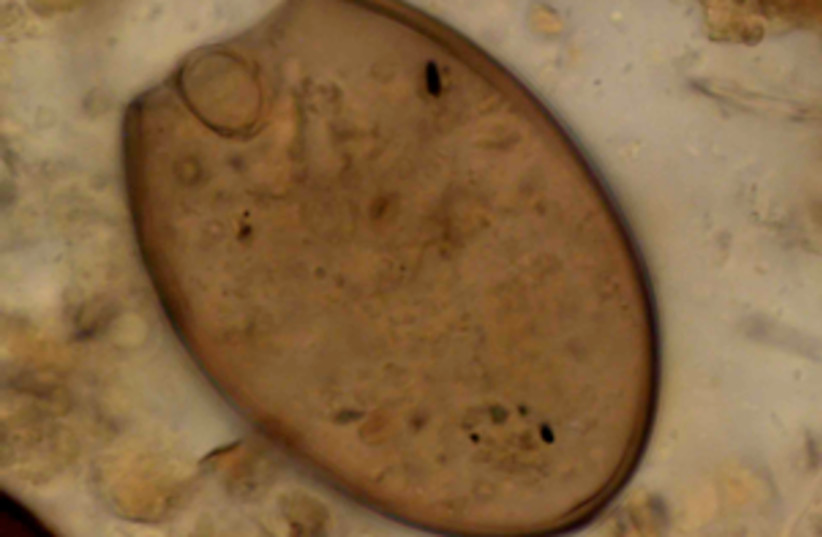
A microscopic fish tapeworm egg found in the medieval latrine at Riga. (photo credit: IVY YEH)
Posted on 10/05/2020 10:54:14 AM PDT by SJackson
The Jerusalem latrine was found in the Christian Quarter of the Old City, close to the Church of the Holy Sepulchre in 1996 during excavations of a cesspool in the courtyard of a Spanish school.
A microscopic fish tapeworm egg found in the medieval latrine at Riga. (photo credit: IVY YEH)
From the bowels of history comes a study published this week in the journal Philosophical Transactions of the Royal Society B at Cambridge University in England, which details a first attempt at using the methods of ancient bacterial detection, pioneered in studies of past epidemics, to characterize the microbial diversity of ancient gut contents from two medieval latrines, one in Jerusalem and one in Riga.
The Jerusalem latrine was found in the Christian Quarter of the Old City, close to the Church of the Holy Sepulchre in 1996 during excavations of a cesspool in the courtyard of a Spanish school.
The Actual Cost Of One Day Full Mouth Dental Implants Might Surprise you (Dental implants | Sponsored listing)
The issue of the journal in which the study appears features articles on the theme, “Insights into health and disease from ancient biomolecules.”
Scientists have long noted a growing body of evidence that has linked changes in the microbiomes of contemporary humans to many of the diseases of the modern industrialized world, such as inflammatory bowel disease, allergies and obesity. The current study helps to characterize the changes in gut microbiomes and highlights the value of ancient latrines as sources of bio-molecular information. The team analyzed sediment from these latrines dating from the 14th-15th century CE. The findings provide insights into the microbiomes of preindustrial agricultural populations, which may provide important context for interpreting the health of modern microbiomes. Gut microbiomes are defined as the collective genome of microbes inhabiting the gut including bacteria, archaea, viruses, and fungi. So any insight into the medieval microbiomes can highlight both changes in diet over the centuries and also in how humans processed their diet.
Piers Mitchell of Cambridge University specializes in the gut contents of past people through analysis of unusual substrates. By looking at the contents of archaeological latrines and desiccated feces under the microscope, he and his team have discovered a great deal about the intestinal parasites that plagued our ancestors. “Microscopic analysis can show the eggs of parasitic worms that lived in the intestines, but many microbes in the gut are simply too small to see,” commented Mitchell. “If we are to determine what constitutes a healthy microbiome for modern people, we should start looking at the microbiomes of our ancestors who lived before antibiotic use, fast food, and the other trappings of industrialization.”
The first challenge scientists faced in investigating the latrines was distinguishing bacteria that formed the medieval gut from those that are normally found in the soil. The use of latrines, where the feces of many people are mixed together, allowed the researchers unprecedented insight into the microbiomes of entire communities.
“These latrines gave us much more representative information about the wider pre-industrial population of these regions than an individual fecal sample would have,” said Mitchell. “Combining evidence from light microscopy and ancient DNA analysis allows us to identify the amazing variety of organisms present in the intestines of our ancestors who lived centuries ago.”
Kirsten Bos, a specialist in ancient bacterial DNA from the Max Planck Institute for the Science of Human History and co-leader of the study, was initially skeptical about the feasibility of investigating the contents of centuries-old latrines.
“At the outset we weren’t sure if molecular signatures of gut contents would survive in the latrines over hundreds of years. Many of our successes in ancient bacterial retrieval thus far have come from calcified tissues like bones and dental calculus, which offer very different preservation conditions. Nevertheless, I was really hoping the data here would change my perspective,” said Bos.
The researchers identified a wide range of bacteria, archaea, protozoa, parasitic worms, fungi and other organisms, including many taxon known to inhabit the intestines of modern humans. “It seems latrines are indeed valuable sources for both microscopic and molecular information,” according to Bos.
Susanna Sabin, a doctoral alumna of the MPI-SHH who co-led the study, compared the latrine DNA to those from other sources, including microbiomes from industrial and foraging populations, as well as waste water and soil.
“We found that the microbiome at Jerusalem and Riga had some common characteristics – they did show similarity to modern hunter gatherer microbiomes and modern industrial microbiomes, but were different enough that they formed their own unique group. We don’t know of a modern source that harbors the microbial content we see here.”
This type of research into microbiomes is just getting started and challenges remain. “We’ll need many more studies at other archaeological sites and time periods to fully understand how the microbiome changed in human groups over time,” said Bos. “However, we have taken a key step in showing that DNA recovery of ancient intestinal contents from past latrines can work.”
ancient microbiome ping
Crappy job...
And there’ll be that movie with Justin Timberlake to bolster the theory.
There a vid on Youtube that puts appropriate sound effects to that.
About fifty five years ago I read a MENTOR book “The Mute Stones Speak” about archaeology digs in Rome.
They found pit toilets from 2000 years ago, and in digging through them found the stench was still so strong they still attracted thousands of flies during the dig.
Wonder what they found in the way of gut problems there.
Disclaimer: Opinions posted on Free Republic are those of the individual posters and do not necessarily represent the opinion of Free Republic or its management. All materials posted herein are protected by copyright law and the exemption for fair use of copyrighted works.